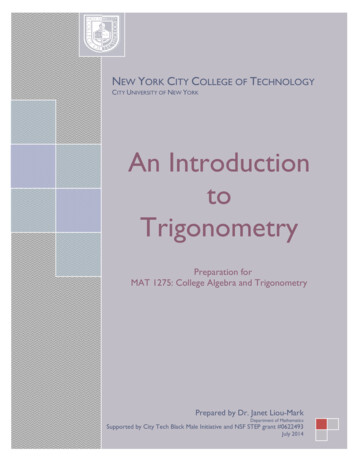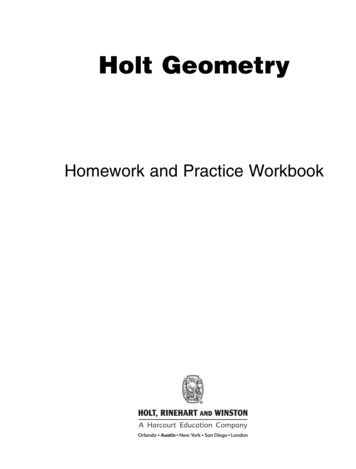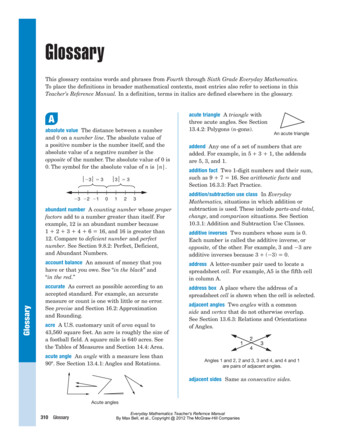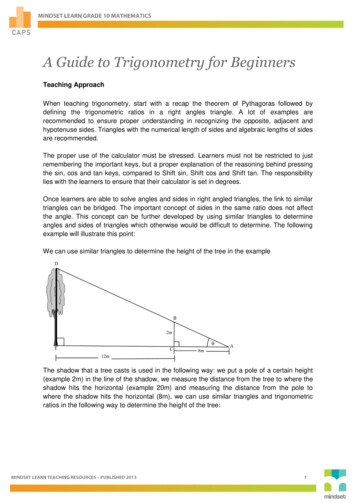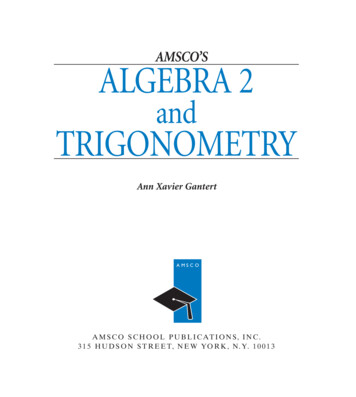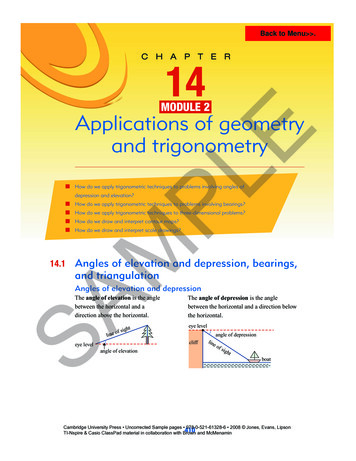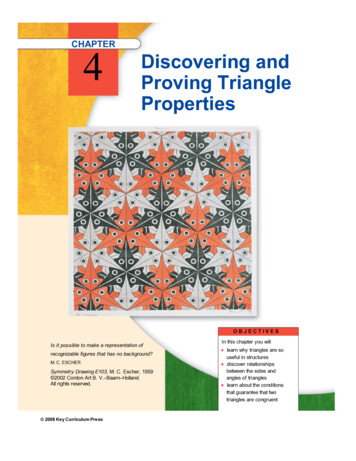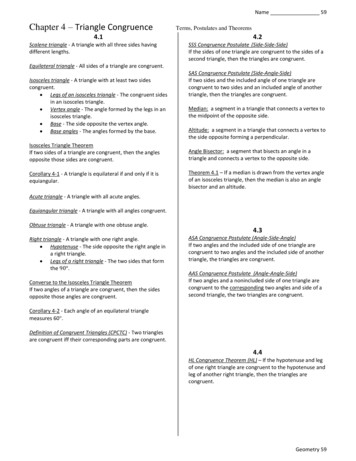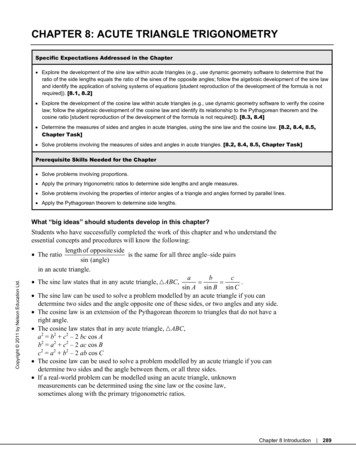
Transcription
CHAPTER 8: ACUTE TRIANGLE TRIGONOMETRYSpecific Expectations Addressed in the Chapter Explore the development of the sine law within acute triangles (e.g., use dynamic geometry software to determine that theratio of the side lengths equals the ratio of the sines of the opposite angles; follow the algebraic development of the sine lawand identify the application of solving systems of equations [student reproduction of the development of the formula is notrequired]). [8.1, 8.2] Explore the development of the cosine law within acute triangles (e.g., use dynamic geometry software to verify the cosinelaw; follow the algebraic development of the cosine law and identify its relationship to the Pythagorean theorem and thecosine ratio [student reproduction of the development of the formula is not required]). [8.3, 8.4] Determine the measures of sides and angles in acute triangles, using the sine law and the cosine law. [8.2, 8.4, 8.5,Chapter Task] Solve problems involving the measures of sides and angles in acute triangles. [8.2, 8.4, 8.5, Chapter Task]Prerequisite Skills Needed for the Chapter Solve problems involving proportions. Apply the primary trigonometric ratios to determine side lengths and angle measures. Solve problems involving the properties of interior angles of a triangle and angles formed by parallel lines. Apply the Pythagorean theorem to determine side lengths.Copyright 2011 by Nelson Education Ltd.What “big ideas” should students develop in this chapter?Students who have successfully completed the work of this chapter and who understand theessential concepts and procedures will know the following:length of opposite side The ratiois the same for all three angle–side pairssin (angle)in an acute triangle.abc The sine law states that in any acute triangle, ABC,. sin A sin B sin C The sine law can be used to solve a problem modelled by an acute triangle if you candetermine two sides and the angle opposite one of these sides, or two angles and any side. The cosine law is an extension of the Pythagorean theorem to triangles that do not have aright angle. The cosine law states that in any acute triangle, ABC,a2 b2 c2 – 2 bc cos Ab2 a2 c2 – 2 ac cos Bc2 a2 b2 – 2 ab cos C The cosine law can be used to solve a problem modelled by an acute triangle if you candetermine two sides and the angle between them, or all three sides. If a real-world problem can be modelled using an acute triangle, unknownmeasurements can be determined using the sine law or the cosine law,sometimes along with the primary trigonometric ratios.Chapter 8 Introduction 289
Chapter 8: Planning ChartPacing10 daysLesson TitleLesson GoalGetting Started, pp. 422–425Use concepts and skills developedprior to this chapter.2 daysruler;protractor;Diagnostic TestLesson 8.1: Exploring the SineLaw, pp. 426–427Explore the relationship betweeneach side in an acute triangle andthe sine of its opposite angle.1 daydynamic geometry software, or rulerand protractorLesson 8.2: Applying the SineLaw, pp. 428–434Use the sine law to calculateunknown side lengths and anglemeasures in acute triangles.1 dayruler;Lesson 8.2 Extra PracticeLesson 8.3: Exploring the CosineLaw, pp. 437–439Explore the relationship betweenside lengths and angle measures ina triangle using the cosines ofangles.1 daydynamic geometry softwareLesson 8.4: Applying the CosineLaw, pp. 440–445Use the cosine law to calculateunknown measures of sides andangles in acute triangles.1 dayruler;Lesson 8.4 Extra PracticeLesson 8.5: Solving Acute TriangleProblems, pp. 446–451Solve problems using the primarytrigonometric ratios and the sineand cosine laws.1 dayruler;Lesson 8.5 Extra Practice3 daysMid-Chapter Review Extra Practice;Chapter Review Extra Practice;Chapter Test;Chapters 7–8 Cumulative ReviewCopyright 2011 by Nelson Education Ltd.Mid-Chapter Review, pp. 435–436Chapter Review, pp. 452–453Chapter Self-Test, p. 454Curious Math, p. 439Chapter Task, p. 455Materials/Masters Needed290 Principles of Mathematics 10: Chapter 8: Acute Triangle Trigonometry
CHAPTER OPENERUsing the Chapter OpenerCopyright 2011 by Nelson Education Ltd.Introduce the chapter by discussing the photograph and map on pages 420and 421 of the Student Book.The photograph shows a view of the Toronto waterfront, and the map showsToronto, Hamilton, and St. Catharines. A triangle has been drawn on themap to connect the three cities. The distance between Toronto and Hamiltonand the distance between Hamilton and St. Catharines have been marked onthe map, as well as the angle formed by the lines between these cities.Invite students to explain what they remember about the three primarytrigonometric ratios: sine, cosine, and tangent. Ask: What information isshown on the map? Encourage discussion about the following question:Why can you not use a primary trigonometric ratio to directly calculate thedistance by air from St. Catharines to Toronto? Ask students to estimate thedistance and to justify their estimates.Tell students that, in this chapter, they will develop two methods for solvingproblems that can be modelled using acute triangles. After completing thechapter, return to the question on page 421. Have students calculate thedistance in pairs or groups and then share their solutions. Alternatively, youcould calculate the distance with the class after completing Lesson 8.5.Chapter 8 Opener 291
GETTING STARTEDUsing the Words You Need to KnowStudents might read each sentence and select the best term to complete it,read each term and search for the sentence in which it fits, or use acombination of these strategies.After students have recorded all the terms to complete the sentences, askthem to share their strategies. Some students may know all the terms. Othersmay have used a process of elimination. Then read each term and askquestions such as these: How would you define this term? What other wordscould you use to explain it? How could you illustrate it? Emphasize thateach term can be defined and illustrated in different ways.Using the Skills and Concepts You NeedWhen discussing angle relationships, ensure that students relate eachrelationship to the angles shown. Work through the example in the StudentBook (or similar examples, if you would like students to have experiencewith more examples), and encourage students to ask questions about thereasons given in the table. Ask students to look over the Practice questionsto see if there are any questions they do not know how to solve. Havestudents work on the Practice questions in class, and assign any unfinishedquestions for homework.Student Book Pages 422–425Preparation and PlanningPacing5 10 minWords You Need toKnow40 45 min Skills and Concepts YouNeed45 55 min Applying What YouKnowMaterials ruler protractorNelson Websitehttp://www.nelson.com/mathIntroduce the activity by modelling the situation. Ask for a volunteer tomark the position of the soccer net on the board, and have students estimateMarco’s position. Then have students work in pairs. After students finish,have some of the pairs describe their strategies for determining the width ofthe net. Ask if there is more than one way to solve the problem. Also ask ifthere is more than one primary trigonometric ratio that can be used tocalculate the width of the soccer net using the two right triangles.Answers to Applying What You KnowA. The angle formed by the posts and Marco’s position is 75 . Since thesum of the angle measures in a triangle is 180 , the total number ofdegrees for the other two angles is 180 – 75 , or 105 . If one of theangles formed by Marco’s position and the goalposts were 90 , the otherangle would be 15 . However, the sides of the triangle that are betweenMarco and the goalposts are 5.5 m and 6.5 m. These lengths are close tothe same length, so the angles formed by the goalposts and Marco’sposition are close to the same measure. None of the angles is a rightangle, so Marco’s position does not form a right triangle.B. A primary trigonometric ratio cannot be used to calculate the width ofthe net directly because the triangle formed by Marco’s position and thegoalposts is not a right triangle.292 Principles of Mathematics 10: Chapter 8: Acute Triangle TrigonometryCopyright 2011 by Nelson Education Ltd.Using the Applying What You Know
C. Draw h from a goalpost perpendicular to the opposite side.h6 .56.5 sin 75º h6.28 hThe height of the triangle is about 6.28 m.E.–F. Begin with the right triangle that contains x and the 75º angle.Calculate the third side, x, of the triangle using the cosine ratio.xcos 75º 6 .56.5 cos 75º x1.68 xThen calculate y.y 5.5 xy 5.5 – 1.68y 3.82Let the width of the soccer net, in metres, be n. Use the Pythagoreantheorem to calculate n.n2 y2 h2n2 3.822 6.282n2 54.03n 54.03n 7.35The width of the soccer net is about 7.4 m.Copyright 2011 by Nelson Education Ltd.D.sin 75º Initial AssessmentWhat You Will See Students Doing When students understand If students misunderstand Students articulately explain why a primary trigonometric ratiocannot be used to calculate the width of the soccer netdirectly.Students may not realize that the triangle is not a righttriangle. They may think that a primary trigonometric ratio canbe used to solve a triangle that is not a right triangle.Students draw the height of the triangle correctly.Students may not know how to show the height of a trianglefrom a vertex at the goalposts so that either the 5.5 m lengthor the 6.5 m length can be used in a right triangle with a 75 angle.Students apply the sine ratio, the cosine ratio, and then thePythagorean theorem to determine the width of the net.Students may not understand how to use the sine ratio,cosine ratio, or Pythagorean theorem or how to connect theinformation for the two triangles they formed.Students write a concluding statement that includes thecorrect answer to the question asked.Students may not connect the results of their calculations withthe situation. They may not use the correct units or answerthe question.Chapter 8 Getting Started 293
8.1 EXPLORING THE SINE LAWGOALExplore the relationship between eachside in an acute triangle and the sineof its opposite angle.Lesson at a GlanceStudent Book Pages 426–427Prerequisite Skills/Concepts Solve problems involving the properties of interior angles of a triangle. Solve problems involving proportions.Specific Expectation Explore the development of the sine law within acute triangles (e.g., usedynamic geometry software to determine that the ratio of the side lengthsequals the ratio of the sines of the opposite angles[; follow the algebraicdevelopment of the sine law and identify the application of solvingsystems of equations [student reproduction of the development of theformula is not required])].Preparation and PlanningPacing5–10 min Introduction35 45 min Teaching and Learning10–15 min ConsolidationMaterials dynamic geometry software, or rulerand protractorRecommended PracticeQuestions 1, 2, 3, 4Nelson Websitehttp://www.nelson.com/mathMathematical Process FocusCopyright 2011 by Nelson Education Ltd. Reasoning and Proving ConnectingMATH BACKGROUND LESSON OVERVIEW In this lesson, students explore the sine law relationship between sides and angles in an acute triangle. The exploration leads to an understanding that in any acute triangle, ABC, the ratioequivalent for all three angle–side pairs and294 asin A bsin B csin C.Principles of Mathematics 10: Chapter 8: Acute Triangle Trigonometrylength of opposite sidesin (angle)is
1Introducing the Lesson(5 to 10 min)Have students work in small groups. Assign a primary trigonometric ratio toeach group, and ask students to discuss the ratio for a few minutes. To helpstudents get started, suggest topics such as: type of triangle for which a primary trigonometric ratio is used relationship represented by each primary trigonometric ratio use of a primary trigonometric ratio to determine a side length use of a primary trigonometric ratio to determine an angle measure connection between tangent and slope diagram to model a primary trigonometric ratio problem that involves a primary trigonometric ratio in the solutionThen ask a member of each group to describe the ratio in a few words, withor without a diagram.Pose these questions: How is an acute triangle different from a righttriangle? Can you use primary trigonometric ratios to solve acute triangles?Why not?2Teaching and Learning(35 to 45 min)Explore the MathHave students work through the exploration in pairs. Ensure that theyconstruct only acute triangles, except in part F.Copyright 2011 by Nelson Education Ltd.If students are using dynamic geometry software, the following ideas maybe helpful: Ensure that students can use the software to measure angles in a triangleand lengths of line segments, as noted in the Tech Support in the margin. Place more experienced users of the software with students who are lessproficient. Encourage students to seek assistance from their neighbourswhen necessary. Remind students to choose the precision for lengths and angle measures,as well as the units. Ensure that students know how to use the calculator in the dynamiclength of opposite side.geometry software to determine the ratiosin (angle) For part F, students could drag vertices to obtain an angle of almostexactly 90º, create a segment and rotate it, or create a right triangle byconstructing a perpendicular line. When they drag the right triangle, theangle must remain a right angle.8.1: Exploring the Sine Law 295
If students are using rulers and protractors, have them measure the sidelengths to tenths of a centimetre and the angles to the nearest degree. Theaccuracy will be less exact than the accuracy with dynamic geometrysoftware.Discuss why results can vary because of precision in measurements andbecause of rounding, when using the calculator in the dynamic geometrysoftware or when using a scientific calculator.Answers to Explore the MathA.–B. Answers may vary, e.g.,length of opposite sideAngleSideSine A 52.3ºa 2.6sin A 0.79a 3.3sin A B 55.5ºb 2.8sin B 0.82b 3.3sin B C 72.2ºc 3.2sin C 0.95c 3.3sin CC. The ratio is the same for all three angles in my triangle.D.296 Principles of Mathematics 10: Chapter 8: Acute Triangle TrigonometryCopyright 2011 by Nelson Education Ltd.sin (angle)
length of opposite sideAngleSideSine A 26.3ºa 2.6sin A 0.44a 6.0sin A B 65.2ºb 5.4sin B 0.91b 6.0sin B C 88.5ºc 6.0sin C 1.00c 6.0sin Csin (angle)length of opposite sideis the same for all three angles in thissin (angle)triangle, but it is different from the ratio for the angles in the firsttriangle.length of opposite sideE. The ratiois always the same for all three anglessin (angle)in a triangle.F.Copyright 2011 by Nelson Education Ltd.The ratiolength of opposite sideAngleSideSine A 48.2ºa 3.9sin A 0.75a 5.2sin A B 41.8ºb 3.5sin B 0.67b 5.2sin B C 90.0ºc 5.2sin C 1.00c 5.2sin Csin (angle)In a right triangle, the ratio is the same for all three angles.For some of the tables, if I calculated the answers using themeasurements in the other columns, some results would be slightlydifferent than my results using the software calculator. The differencesare because of the precision in the measurements and because ofrounding.8.1: Exploring the Sine Law 297
G. Replacing the sine ratio with the cosine or tangent ratio does not give thesame results. The cosine ratios are not the same for all three angles in atriangle. Similarly, the tangent ratios are not the same.H. i) In an acute triangle, the ratio of the length of a side to the sine of theopposite angle is equivalent for all three angle–side pairs.abcii) In an acute triangle ABC,. sin A sin B sin CAnswers to ReflectingI. Since the relationship involves the sine ratio, an appropriate name couldbe the sine law.J. Yes. Write the ratio of the length of the known side to the sine of theangle opposite the side. Create an equivalent ratio for the unknown sidelength and the sine of the opposite known angle, or for the length of theknown side and the sine of the unknown opposite angle. Equate the tworatios, and solve for the unknown. If you know two of the angles, youcan calculate the third angle and then use ratios to solve for the unknownside length.3Consolidation(10 to 15 min)Students should understand that the ratio of the length of a side to the sine ofthe opposite angle is equivalent for all three angle–side pairs in an acutetriangle. Students should also understand that this relationship can be usedto determine unknown side lengths and angle measures in an acute triangleif enough information is known.Copyright 2011 by Nelson Education Ltd.Students should be able to answer the Further Your Understanding questionsindependently.298 Principles of Mathematics 10: Chapter 8: Acute Triangle Trigonometry
8.2 APPLYING THE SINE LAWGOALUse the sine law to calculate unknownside lengths and angle measures inacute triangles.Lesson at a GlancePrerequisite Skills/ConceptsStudent Book Pages 428–434length of opposite sideis the same for all threesin (angle)angle–side pairs in an acute triangle. Apply the primary trigonometric ratios to determine side lengths andangle measures. Solve problems involving the properties of interior angles of a triangleand angles formed by parallel lines. Solve problems involving proportions. Understand that the ratioSpecific Expectations [Explore the development of the sine law within acute triangles (e.g., usedynamic geometry software to determine that the ratio of the side lengthsequals the ratio of the sines of the opposite angles;] follow the algebraicdevelopment of the sine law and identify the application of solvingsystems of equations [student reproduction of the development of theformula is not required]). Determine the measures of sides and angles in acute triangles, using thesine law [and the cosine law]. Solve problems involving the measures of sides and angles in acutetriangles.Preparation and PlanningPacing5 10 min Introduction30 40 min Teaching and Learning15 20 min ConsolidationMaterials rulerRecommended PracticeQuestions 3, 4, 6, 7, 8, 9, 11, 14Key Assessment QuestionQuestion 7Extra PracticeLesson 8.2 Extra PracticeNew Vocabulary/Symbolssine lawNelson Websitehttp://www.nelson.com/mathCopyright 2011 by Nelson Education Ltd.Mathematical Process Focus Problem Solving Selecting Tools and Computational Strategies RepresentingMATH BACKGROUND LESSON OVERVIEW In Lesson 8.1, students explored the relationship between each side in an acute triangle and the sine of its oppositeangle. They discovered that the ratiolength of opposite sidesin (angle)is equivalent for all three angle–side pairs. In Lesson 8.2, students learn the name of this relationship: the sine law. Students use the sine law to determine unknown side lengths and angle measures in acute triangles. They also usethe sine law to solve problems that involve acute triangles.8.2: Applying the Sine Law 299
1Introducing the Lesson(5 to 10 min)Initiate a discussion about the exploration for Lesson 8.1 by invitingstudents to explain their discoveries in their own words and to illustrate theirdiscoveries on the board, as appropriate. Alternatively, students could spenda few minutes discussing the exploration in groups. Ask them to decidewhat they think was their most important discovery in the exploration. Havea student from each group present their decision to the class.2Teaching and Learning(30 to 40 min)Learn About the MathExample 1 shows that the sine law is true for all acute triangles. It allowsstudents to discuss a proof of the sine law. Help students understand howthis proof extends their exploration for Lesson 8.1, in which they obtainedequivalent ratios. Using the prompts, lead students through the steps in theproof.A. Ben needed to create two right triangles. He used one right triangle todetermine an expression for sin B and the other right triangle todetermine an expression for sin C. Since AD was the opposite side in ABD and in ACD, he was able to relate the two triangles.B. If Ben drew a perpendicular line segment from vertex C to side AB, heabandare equal.would be able to show that the ratiossin Asin BC. The expressions c sin B and b sin C both describe AD and can be setequal to each other. Instead of dividing both sides of the equation bysin C and then by sin B, both sides can be divided by b and then by c.This will still result in an equation that describes only one side of thesin B sin Ctriangle on each side:. Similarly, dividing the second bcsin A sin C. Therefore,equation by a and then by c will result in acit makes sense that the sine law can also be written in the formsin A sin B sin C. abc300 Principles of Mathematics 10: Chapter 8: Acute Triangle TrigonometryCopyright 2011 by Nelson Education Ltd.Answers to Reflecting
3Consolidation(15 to 20 min)Apply the MathUsing the Solved ExamplesIn Example 2, three angle measures and the length of one side of an acutetriangle are given, so one angle–side pair and the measure of another anglecan be used to determine a side length. Students could talk about thesolution in pairs, before a class discussion. Encourage students to take anactive role in explaining the steps in the example in their own words. Posequestions such as these: How do you think Elizabeth decided which angle measures to use? If she had known only the measures of A and C, how could she havesolved the problem? Why does it make sense that side b is shorter than side a?In Example 3, two side lengths and one angle measure are given, so oneangle–side pair and the length of another side can be used to determine anangle measure. Discuss how using the form of the sine law with sine in thenumerator makes it easier to calculate the solution. Since the final step in thesolution uses the inverse of the sine ratio, a brief review of the inverse maybe helpful.Example 4 presents a problem that can be modelled with an acute triangle.Two angles and one side are given, but not an angle–side pair. Studentsshould understand how the measure of the third angle is determined byusing the sum of the angles in a triangle.Copyright 2011 by Nelson Education Ltd.Answer to the Key Assessment QuestionStudents should draw a diagram to help them visualize the parallelogram inthe multi-step problem for question 7. Students could use the informationabout parallelograms from Lesson 2.4, In Summary, as a reference. Afterstudents complete the solution, ask them to explain the steps.7. The long sides of the parallelogram measure 15.4 cm, to the nearesttenth of a centimetre.ClosingQuestion 14 gives students an opportunity to summarize a situation in whichthe sine law can be used to solve a problem. Students might complete thequestion on their own or with a partner. After students have completed thequestion, have them share their solutions: Invite a student to explain her or his solution to the class or a group. Thenask for a few different solutions. Emphasize that measurements can bedetermined in different ways. Ask: How are all the solutions the same?How are some solutions different from other solutions?8.2: Applying the Sine Law 301
Alternatively, have a student draw the triangle on the board. Then ask theclass: What could you calculate? How? What could you calculate next?How? When finished, provide time for students to compare their ownsolution with the class solution.Ensure that students realize how the sum of the interior angles of a trianglecan be used to determine R.Assessment and Differentiating InstructionWhat You Will See Students Doing When students understand If students misunderstand Students write the sine law correctly, with the value to bedetermined in the numerator.Students may be unable to identify opposite angles and sides.They may substitute incorrectly because of errors wheninterpreting measurements or drawing diagrams. They maynot write the sine law with the value to be determined in thenumerator.Students solve an equation correctly and state the results in aconcluding sentence.Students cannot solve proportions by isolating the value to bedetermined and then calculating and rounding. They may notremember how to use the inverse sine, or they may not statethe solution in a concluding sentence to answer the question,using the correct units.Students create and label a parallelogram correctly to modelthe situation.Students cannot create or label a parallelogram correctly tomodel the situation. They may label the given sidesincorrectly.Students realize that they need to determine the angleopposite a short side of the parallelogram. Then they use thesum of the interior angles of a triangle to determine the angleopposite a long side of the parallelogram.Students may have difficulty with multi-step problems. Theymay not realize that they need to determine the angleopposite a short side of the parallelogram before they candetermine the angle opposite a long side.Students use the sine law to determine the length of the longsides of the parallelogram.Students may correctly calculate the angle opposite a shortside but use this angle in the sine law to determine the lengthof a long side.Differentiating Instruction How You Can RespondEXTRA SUPPORT1. To help students visualize a triangle, guide them as they draw a diagram with both the given and unknown informationmarked. Suggest circling the information for each ratio in a different colour. Help them note whether they are determining aside length or angle measure, and remind them to place this value in the numerator of the sine law.2. Suggest strategies for checking accuracy. Students might divide the sine of each angle by the length of the opposite side tocheck that they are equal, divide the length of each side by the sine of the opposite angle to check that they are equal, oradd the angle measures to check that the sum is 180 .EXTRA CHALLENGE1. Students could create problems that can be solved using the sine law and then solve their problems.2. Have students investigate real-world situations in which the sine law would be useful. The contexts used for the Practisingquestions in Lesson 8.2 might help students think of situations to investigate.302 Principles of Mathematics 10: Chapter 8: Acute Triangle TrigonometryCopyright 2011 by Nelson Education Ltd.Key Assessment Question 7
MID-CHAPTER REVIEWBig Ideas Covered So Far The ratiolength of opposite sidesin (angle)is the same for all three angle–side pairs in an acute triangle. The sine law states that in any acute triangle, ABC,asin A bsin B csin C. The sine law can be used to solve a problem modelled by an acute triangle if you can determine two sides and the angleopposite one of these sides, or two angles and any side.Using the Frequently Asked QuestionsHave students keep their Student Books closed. Display the Frequently Asked Questions on a board. Have students discuss thequestions and use the discussion to draw out what the class thinks are good answers. Then have students compare the classanswers with the answers on Student Book page 435. Students can refer to the answers to the Frequently Asked Questions asthey work through the Practice Questions.Using the Mid-Chapter ReviewAsk students if they have any questions about any of the topics covered so far in the chapter. Review any topics that studentswould benefit from considering again. Assign Practice Questions for class work and for homework.To gain greater insight into students’ understanding of the material covered so far in the chapter, you may want to ask questionssuch as the following: How do you decide which sides and angles to use in the ratios for the sine law? How are solutions that use the sine law to determine a side length the same as solutions that use the sine law to determinean angle measure? How are these solutions different? The sine law can only be used if certain information about an acute triangle is given. Explain why. How would you explain the inverse sine ratio? What other way could you explain it?Copyright 2011 by Nelson Education Ltd. What have you learned about the sine law?Chapter 8 Mid-Chapter Review 303
Lesson at a GlanceGOALExplore the relationship between sidelengths and angle measures in atriangle using the cosines of angles.Prerequisite Skills/Concepts Solve problems involving proportions. Apply the Pythagorean theorem to determine side lengths.Specific Expectation Explore the development of the cosine law within acute triangles (e.g.,use dynamic geometry software to verify the cosine law[; follow thealgebraic development of the cosine law and identify its relationship tothe Pythagorean theorem and the cosine ratio [student reproduction of thedevelopment of the formula is not required]).]Mathematical Process Focus Reasoning and Proving ConnectingStudent Book Pages 437–439Preparation and PlanningPacing5 10 min Introduction35 45 min Teaching and Learning10 15 min ConsolidationMaterials dynamic geometry softwareRecommended PracticeQuestions 1, 2, 3, 4, 5New Vocabulary/Symbolscosine lawNelson Websitehttp://www.nelson.com/mathMATH BACKGROUND LESSON OVERVIEW Students should understand the Pythagorean theorem. In this lesson, students explore the cosine law for an acute triangle, ABC:a2 b2 c2 – 2 bc cos Ab2 a2 c2 – 2 ac cos Bc2 a2 b2 – 2 ab cos C The cosine law is an extension of the Pythagorean theorem to triangles that do not have a right angle.304 Principles of Mathematics 10: Chapter 8: Acute Triangle TrigonometryCopyright 2011 by Nelson Education Ltd.8.3 EXPLORING THE COSINE LAW
1Introducing the Lesson(5 to 10 min)Begin by reviewing the Pythagorean theorem: Draw and label an acute triangle, ABC. Ask students why the Pythagorean theorem cannot be used to determinethe measure of c. (The triangle does not have a right
Lesson 8.2 Extra Practice Lesson 8.3: Exploring the Cosine Law, pp. 437–439 Explore the relationship between side lengths and angle measures in a triangle using the cosines of angles. 1 day dynamic geometry software Lesson 8.4: Applying the Cosine Law, pp. 440–445 Use

